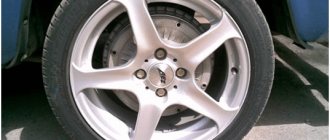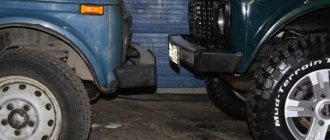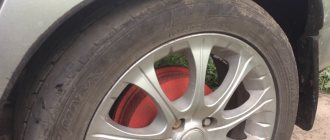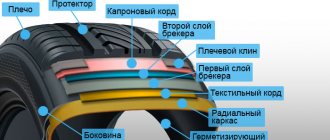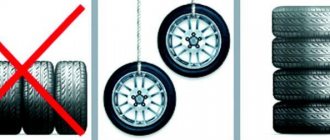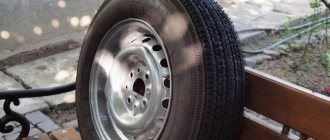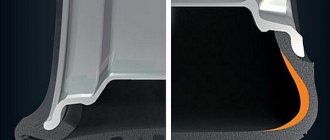If you are reading this article, then you already know that there are two types of tires - tubed and tubeless, therefore, you are interested in which one is better. This is exactly what this article will be about today. In the section “Which is better?” We have more than once weighed the pros and cons of this or that controversial issue, today we’ll talk about tires, and more specifically, whether tubed or tubeless tires are better. Go…
- The marking of tube tires is TT (from the English Tube Type - tubular, tube type or simply tube type).
- Tubeless tires are usually designated - (TL from the English. Tubeless - without a tube, tube or simply tubeless).
The difference between tubeless tires and tube tires
Tubeless tires were first developed in 1903 by Dunlop, which is currently part of the Goodyear group. The engineers and developers of that time could not understand why the new invention of existing tube tires was better, so tubeless tires entered mass production only in 1954. Since then, the struggle between two species of stingrays began.
You can distinguish between tubeless and tube tires by the markings on the sidewall. If there is a tube on the tire there will be an inscription in English “Tube Type”. Tubeless tires are marked with the designation Tubeless.
The main difference between a tubeless tire is the absence of a tube inside. Tightness is ensured by the tight fit of the rubber to the wheel rim. To prevent air from escaping, the rim has a shelf, and the tire grips it with its rounded protrusions.
The difference between a tubeless and a tube tire becomes apparent when a puncture occurs. The hole in the chamber allows air to escape quickly. The reason for this is the lack of tightness in the rim area of the disc. The rate of air release in tubeless tires depends on the size of the damage. If the puncture was caused by a nail or screw, the slope will deflate very slowly. A stuck foreign object acts as a plug. Therefore, with a nail driven into the slope, you can continue to drive only by occasionally pumping up the tire.
Modern tubeless tires have a complex structure. Developers are experimenting with the tread pattern, trying to endow the slope with certain performance characteristics.
A tube tire, unlike a tubeless tire, consists of two elements: a tire and a tube. The first serves for mechanical protection and provides traction on ice. The chamber is made of elastic rubber and is inflated with air.
A brief overview of the main differences between the two types of tires is presented below.
Table - Brief overview of the differences between tubed and tubeless tires.
| Criterion | Tubeless tire | Tire with tube |
| Puncture safety | High | Low |
| Weight | Depends on design, but usually small | Always higher than tubeless |
| Maintainability | Depends on damage | Time-consuming, but can be done with your own hands |
If there is no marking on the tire, for example, due to abrasion, then you can distinguish the two types of rubber by the nipple. For a tube tire it is smooth and long. A tubeless wheel has a short nipple with a small flange. On a lowered wheel with a camera, the nipple can be pressed inward. A tubeless tire doesn't allow you to push it in. The nipple is rigidly attached to the surface of the disk, as it directly affects the tightness.
If you cannot determine the presence of a camera by external signs, then you can resort to a radical method of checking the wheel. To do this, the tire must be beaded. If there is no tube underneath, then the wheel is tubeless. This method should be used only in extreme cases, as there is a high risk of damaging the rim or slope.
The main reasons for loss of pressure in a tubeless wheel when there is no damage to the tire
In such cases, the defect may lie in the following situations, which you must pay attention to:
- Tubeless tire goes flat - what to do? The first thing that needs to be checked is the condition of the nipple valve, since it can fail due to high pressure inside the wheel, as well as under aggressive environmental influences. The rubber on it often becomes tanned, dries out and cracks, which ensures depressurization of the entire system. In such cases, the car enthusiast only needs to replace the nipple and continue driving.
- The nipple itself is attached directly to the rim from the inside in such a way that its sole is pressed against the wheel, and this compression only intensifies under pressure. The metal part - the nipple sticks out for easy control of pressure and inflation of the tire. So, this fastener can break or become depressurized, for example, from poor-quality glue, and the nipple also requires replacement.
- Since the tire only fits tightly to the side of the rim of the disc, without providing any adhesion, it is held there due to the rigidity of the cord. If there are any jams or defects on the side of a steel or light-alloy wheel, then the seal can easily be broken, and the wheel will go flat until the owner rolls the disk or replaces it.
- Poor quality tires. So, it may have a weak cord or is itself made with curvature, and in some cases it may simply wear out over time in such a way that it can no longer ensure a tight connection.
- Such a defect can be revealed if the tire size is selected incorrectly, and that is why there is a special table for matching the parameters of disks and tires, based on which the driver can be sure that their connection will be absolutely sealed.
Repairing tubeless tires without removing the wheel
Use of tubed and tubeless tires
Tubeless tires are currently the leader in popularity for use on passenger cars. Also, many trucks and buses have moved away from using tires. Still, the cameras found their place. They are used on motorcycles, bicycles, scooters, scooters, mopeds, scooters and ATVs. They are used in conjunction with spoked wheels. The reason for this is the difficulty of ensuring the tightness of a tubeless tire on such a rim.
Tube tires have not completely disappeared from trucks and light trucks. The reason for this is the installation and inflation features of tubeless wheels.
Representatives of the “Soviet generation” also prefer to install tube tires. The reason for this is the ease of repairing the wheel yourself. It is also worth noting that replacing a tube without a tire is much cheaper than restoring a tubeless wheel at a service center.
Advantages of tubeless tires
The main advantage of tubeless tires is puncture safety. If a tire breaks down, it maintains normal pressure for a long time. In most cases, it is possible to travel from several tens to several hundred km. If you pump up the tire regularly, you can drive even more with a puncture.
The absence of an immediate drop in pressure in the wheel during a breakdown allows you to avoid losing control and not getting into a traffic accident. Therefore, tubeless tires are widely used on passenger cars and trucks.
Modern tubeless tires have less weight. This reduces the load on the suspension. Vehicle dynamics are also improved.
Tubeless tires transfer heat better to the metal wheel rim, as they fit more tightly to it. Therefore, rubber heats up and wears out less, and its performance characteristics remain more stable.
Easier and faster repairs for minor damage. There are special pastes, sprays, plugs, and tourniquets on sale that instantly solve the puncture problem. However, it should be borne in mind that after such a restoration it is still recommended to contact a service center.
Tubeless tires have no internal friction between the tube and the tire. This allows you to increase the service life. All other things being equal, it is 10-12% more.
FRAMEWORK
TEXTILE or COMBINED tires are tires with a textile frame consisting of five or more layers of rubberized nylon or nylon cord and a breaker made of metal threads. The combination of a carcass with a meridional arrangement of cord threads and a belt in radial tires increases performance characteristics in comparison with diagonal tires. Michelin was the first to use metal cord in the carcass of radial textile tires back in the late 40s of the last century, which significantly improved performance characteristics due to its high tensile rigidity, endurance and thermal conductivity.
However, even in those years, the truck combined radial tire with a textile frame ceased to meet the growing demands of motorists for reliability, safety and maximum speed, especially in conditions of long-term non-stop driving.
CMK or ALL STEEL – all-metal cord tires are tires in which the frame consists entirely of steel threads, without the use of textile materials;
- Thanks to the “all-metal cord” design, these tires received higher performance qualities, as well as the possibility of repeated tread renovation, by “cutting” or “welding”.
- Additional components are added to the rubber mixture of such tires, which provide the possibility of long-term non-stop operation of the vehicle, which is also important for freight transportation. These components reduce overheating of the tire while driving.
- The downside of this technology is that the cost of solid metal tires is higher than that of tires made using classical technology. This is because solid steel tires are more difficult to manufacture. But this difference is compensated by a longer service life, fuel economy, load capacity and other advantages.
- If the mileage of a conventional “combined” tire rarely exceeds 100,000 km, then an all-metal tire, depending on the technological features, brand and cost of the tire, can travel more than 500,000 km.
- In developed countries, solid steel tires have been produced since the early 80s of the last century and have gained popularity due to their undeniable advantages in comparison with combined tires;
- In Russia, to this day, many manufacturers equip their vehicles with combined tires, this is due to the effect of old standards for packaging, and the fact that automakers, first of all, produce cars, and it is important for them to make the final product as cheap as possible, and the interests of the consumer fade into the background .
- By moving away from using “combined tires”, in favor of all-in-one tubeless tires, the consumer receives:
UNCONDIBLE ADVANTAGES
- Modernity;
- Metal carcass;
- Increased mileage;
- Increased mileage from 180,000 km;
- Increased load capacity;
- Fuel savings by 15%;
- Pressure stability;
- Reduced deformation;
- Better self-cleaning properties of the tread;
- Reduced rolling resistance;
- Reduced heat generation;
- High speed resistance;
- Possibility before cutting the tread;
- Possibility of retreading;
Disadvantages of tubeless tires
Installing tubeless tires requires special equipment and higher skills from the technician. Any damage to the tire bead or rim can cause depressurization. It should be borne in mind that in this case, subsequent repairs are not always able to restore the wheel.
Repairing tubeless tires often costs a lot of money. The reason for this is the need to use special equipment and the presence of a highly qualified craftsman.
Another disadvantage is the greater sensitivity to tire pressure. Driving for a long time with a flat tire leads to the destruction of the sealing layer. In most cases, it is impossible to restore the slope after this.
Many tubeless tires have a soft sidewall. This makes it easier to damage. Repairing such a wheel is very expensive.
One of the main vulnerabilities of tubeless tires is their high sensitivity to damage to the rim. Any small dent after falling into a hole or hitting a curb will lead to a rapid loss of pressure and the inability to continue further movement.
Tire installation
When installing tubeless tires, you need to consider the following aspects:
- All wheels must have the same type of tires. You cannot change the wheels on the front axle only to improve driving safety. This can lead to loss of vehicle stability on the road and an accident.
- Tires without an inner tube can only be installed on wheels that have protrusions on the rim - humps. They ensure a tight fit for tubeless tires.
- To install tires of this type, special tools are required, so you need to go to a service station to remount the wheels. An attempt at self-installation by an inexperienced user may result in damage to the side and depressurization of the structure.
- You cannot install a tube in a tubeless tire. Some technicians offer this service when a tire develops damage beyond repair. However, when moving, an air cushion forms in such a wheel, which puts pressure on the rubber from the inside and damages the cord during sharp turns and braking.
Recommendations for tire alignment
When choosing tubeless tires, the most important thing to pay attention to is their size. The slopes must be suitable in diameter, profile height and width. Attention should also be paid to the load index and speed. The first indicator should be 15% more than the expected load on the wheel. The recommended speed index depends on the driving style and dynamic characteristics of the car. It should be borne in mind that you should not try to buy wheels with an excessively high permissible speed. They can be too stiff and have mediocre grip and noise levels at low speeds.
The second thing you should pay attention to when choosing tubeless tires is their season. It is prohibited to use summer tires in winter and vice versa. They differ in tread pattern, sidewall design, chemical composition of the rubber compound and cord.
It is advisable to pay attention to the tires having a radial design. Diagonal slopes are produced less and less, but are still available for sale. They are not suitable for urban use.
It is recommended to pay attention to the tread pattern. A universal option is non-directional. It should be noted that the directional pattern removes water and slush better, therefore it is more relevant for rainy regions.
When choosing tubeless tires, you should also pay attention to the price. Although it is not the main criterion for quality, it can tell you a lot. Good tires can't be too cheap.
DESIGN
DIAGONAL - cord threads consist of polymer materials, in the frame and belt and are located at an angle of 35-40 degrees in the diagonal direction from rim to rim, in several even layers (2, 4, 6, 8, etc.), such placement of threads The cord provides optimal load distribution, which makes impacts easier.
ADVANTAGES
- The simple design of such tires seriously reduces the cost;
- The side part has high strength;
- A diagonal tire actively absorbs the loads that occur when a wheel falls into a hole;
- Good maintainability.
1. Sealing layer for tubeless tires; 2. Side part; 3. Frame layers; 4. Protector; 5. Location of cord threads;
RADIAL - cord threads can be either in a combined version and consist of polymer materials and steel in areas that are in the contact patch with the road surface, or in all-metal (solid metal) and located at an angle of 90°.
The breaker is a thin steel cable coated with brass, a cable with a diameter of 0.15 - 0.25 mm, consisting of two or three high-strength layers, with increased ability to conduct heat and resist thermal aging.
The frame consists of one radial layer.
All parts of the tire, the tread and the sidewall, work independently, so the sidewall deflection is not transferred to the tread.
ADVANTAGES
- Long service life;
- Low rolling resistance;
- Fewer breaker layers contribute to:
- Good removal of thermal energy;
- Less heating;
- Better handling in any weather;
- Less weight reduces:
- Fuel consumption;
- Load nodes;
1. Sealing layer for tubeless tires; 2. Side part; 3. Frame; 4. Protector; 5. Breaker layers;
Review of tubeless tire manufacturers
One of the leaders in tire production is Bridgestone. Its tires have a high service life and often win tests. Another Japanese company Yokohama enjoys the same popularity. The concern's ramps can be found in the basic configuration of many car manufacturers.
One of the oldest brands is Michelin. The company was founded in 1830. The high performance of the tires is confirmed by their use in auto racing.
Goodyear, Continental, Dunlop, Toyo Tires, Nokian and Pirelli have a long history and vast experience. The companies produce excellent tires that do not let you down on any road surface.
In the CIS, some of the best are PJSC Omskshina and PJSC Nizhnekamskshina. They have tightly occupied the budget segment. The products of the Moscow Tire and Yaroslavl Tire Plants have mediocre reviews.
